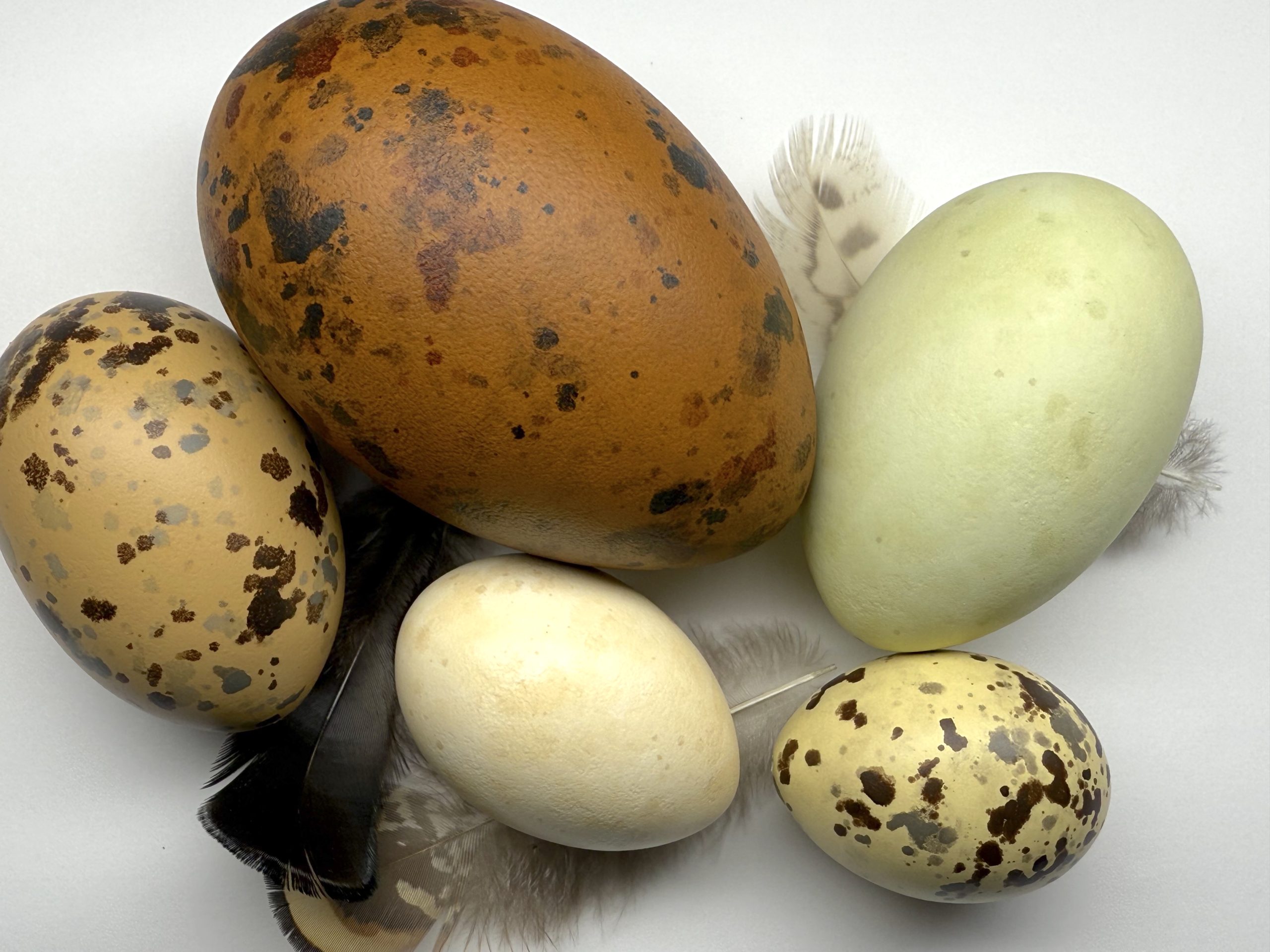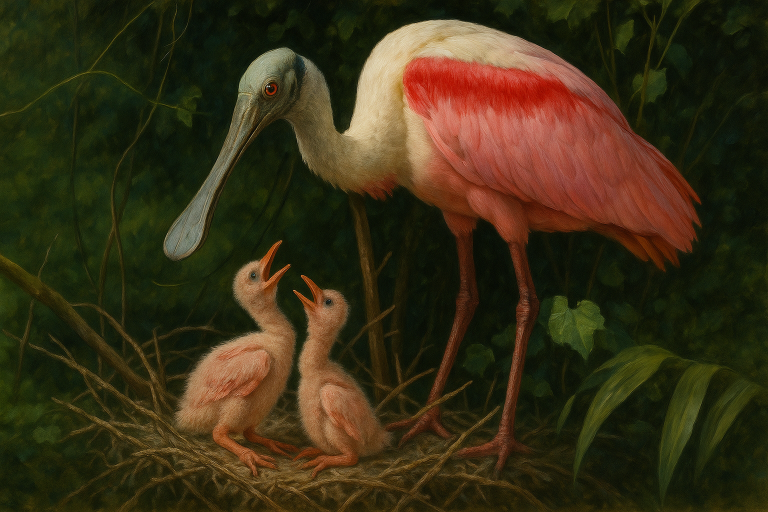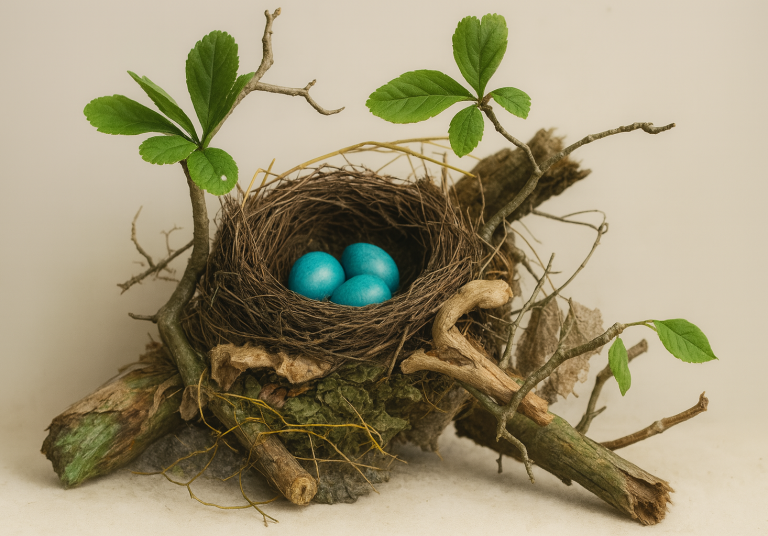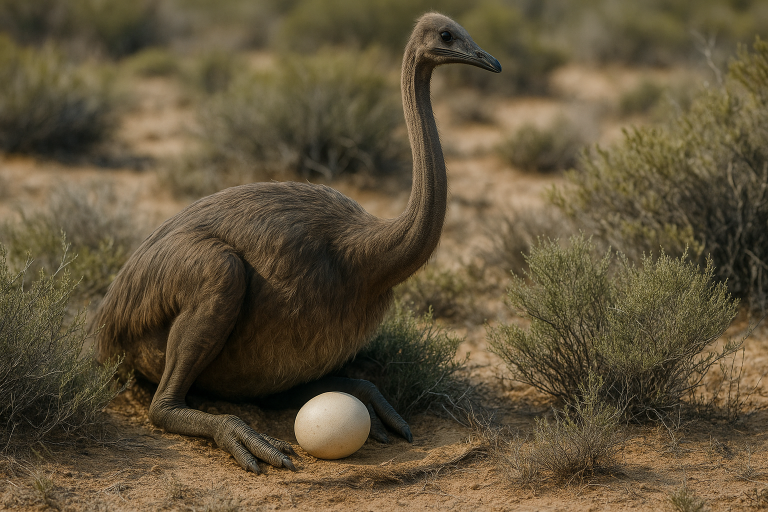Egg Coloration in Birds
Introduction
Bird eggs exhibit a remarkable variety of colors and patterns, ranging from plain white to vibrant blue-green or speckled brown. This diversity is unique among extant species. Reptile eggs, such as crocodiles, are uniformly white, whereas bird eggs have evolved extensive coloration after birds transitioned from hiding eggs to laying in more exposed nests. Egg coloration results from specific pigments deposited in the shell and often serves adaptive functions. These functions can include camouflage from predators, communication or signaling between parents, and even structural reinforcement of the eggshell. In this paper, we examine the pigments responsible for egg colors, the process of pigment deposition during egg formation, the biological purposes of colored eggs, variations across species and environments, and the influences of diet, health, and genetics on egg color. Examples from a variety of bird species are included to illustrate these concepts.
Pigments involved in egg coloration
Despite the kaleidoscope of egg colors in nature, only two primary pigments are responsible for nearly all bird egg coloration. These pigments are synthesized in the female’s reproductive tract and deposited onto or within the eggshell before the egg is laid. The two main pigments are:
- Biliverdin (blue-green pigment)
Biliverdin is a blue-green bile pigment, a product of heme (hemoglobin) breakdown. It imparts blue to green shades to eggshells. For example, the blue-green hue of an American Robin’s egg or an Eastern Bluebird’s egg comes from biliverdin deposited in the shell. Biliverdin and its zinc chelate form are responsible for blue and green tones in eggshells. This pigment is an antioxidant byproduct of blood metabolism and is derived from the breakdown of hemoglobin’s heme group in the uterus during egg formation. The presence of biliverdin can result in a solid blue or green eggshell, as in the case of some chicken breeds like Araucana or wild species like the Emu’s green egg, or contribute to a greenish ground color beneath other markings. - Protoporphyrin IX (reddish-brown pigment)
Protoporphyrin is a reddish-brown pigment that produces brown, rust, red, or purplish spotting and background colors. It is a porphyrin pigment also related to the hemoglobin synthesis pathway. A vivid example of this pigment in action is the deep brick-red color of a Cetti’s Warbler egg. The speckles on many bird eggs, such as quail or turkey eggs, are formed by localized deposits of protoporphyrin. In domestic chickens, the brown coloration of eggs is caused by protoporphyrin coating the outer shell, whereas the interior of a brown egg remains white calcium carbonate due to pigment being mostly superficial.
All bird species are thought to have the basic genetic machinery to produce both biliverdin and protoporphyrin, even if some species use only one or neither of the pigments. Pure white eggs result when no pigment is deposited. Different combinations of these two pigments, varying in proportion and distribution, account for the full spectrum of egg colors and patterns. For example, an egg may have a blue-green base (biliverdin) with brown speckles (protoporphyrin), as is common in many passerines such as the Eurasian Blackbird. More of one pigment and less of the other will change the egg’s appearance. For example, olive-colored eggs result from mixing of brown and green. In rare cases, additional pigment derivatives such as bilirubin or zinc-biliverdin complexes may be present in small amounts, but biliverdin and protoporphyrin are the dominant chromophores in bird eggshells.
Egg formation and pigment deposition
Bird eggshells form in the oviduct of the female, and pigmentation occurs during the latter stages of egg formation. After ovulation, an egg spends roughly 24 hours traveling through the oviduct. The shell is deposited in the shell gland (uterus) portion of the oviduct, where calcium carbonate crystallizes to form the hard shell over about 18–20 hours. Pigments are added during the final hours of shell formation, in the shell gland, just before the egg is laid. In fact, the timing is such that most pigment deposition happens in the last 3–5 hours prior to laying, when the eggshell’s outer calcite layers and cuticle are being formed. Uterine epithelial cells secrete the pigments into the uterine fluid, which then deposits onto the eggshell surface and pores while the shell is still forming. This means the location of pigment is typically in the outermost layers of the shell and the cuticle.
Figure 1: A variety of bird egg colors and patterns across species. Each egg’s appearance results from different amounts and arrangements of biliverdin (blue-green) and protoporphyrin (brown) pigments. Many species lay a blue or green ground-colored egg with superimposed brown speckles, while others lay unmarked white, solid blue, or solid brown eggs.
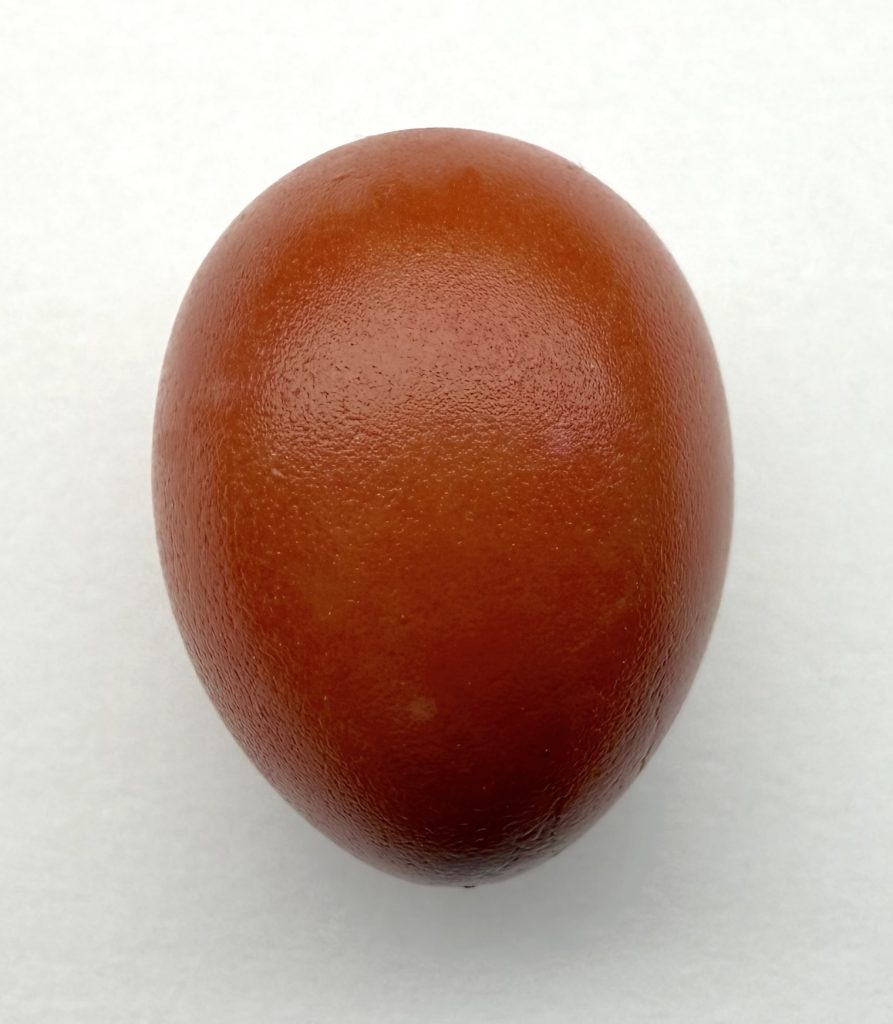
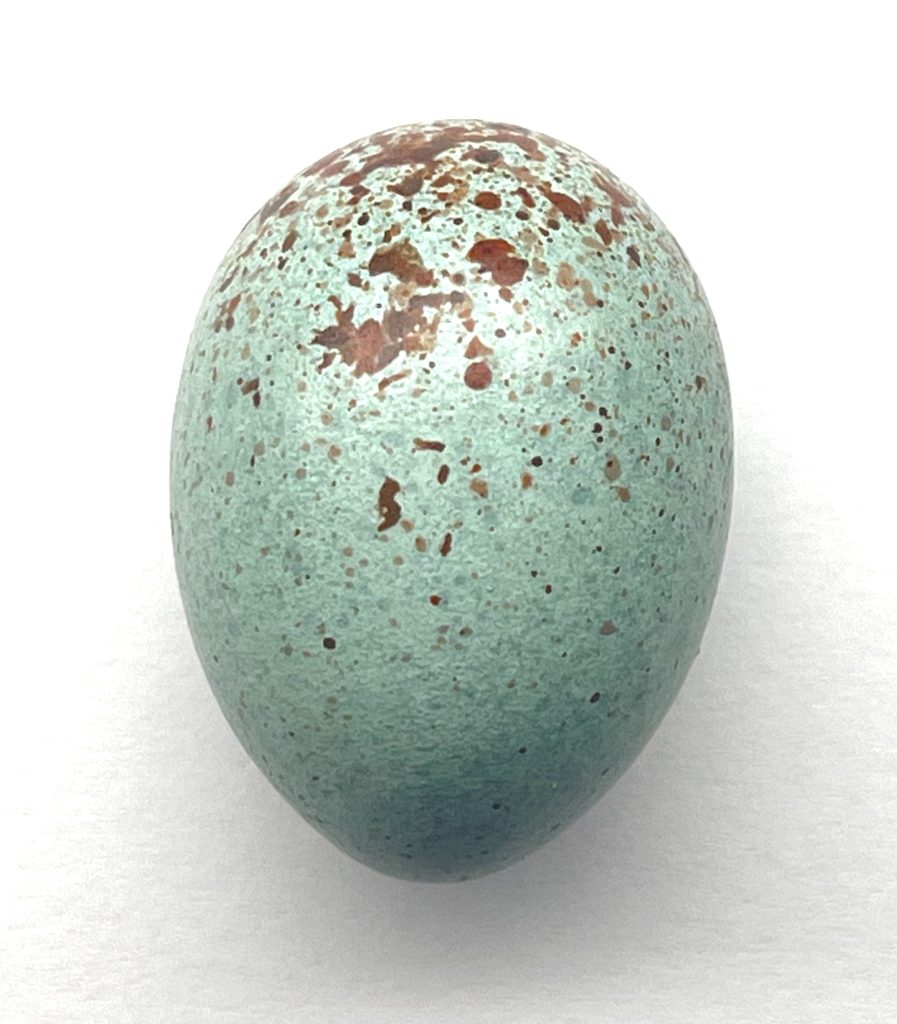
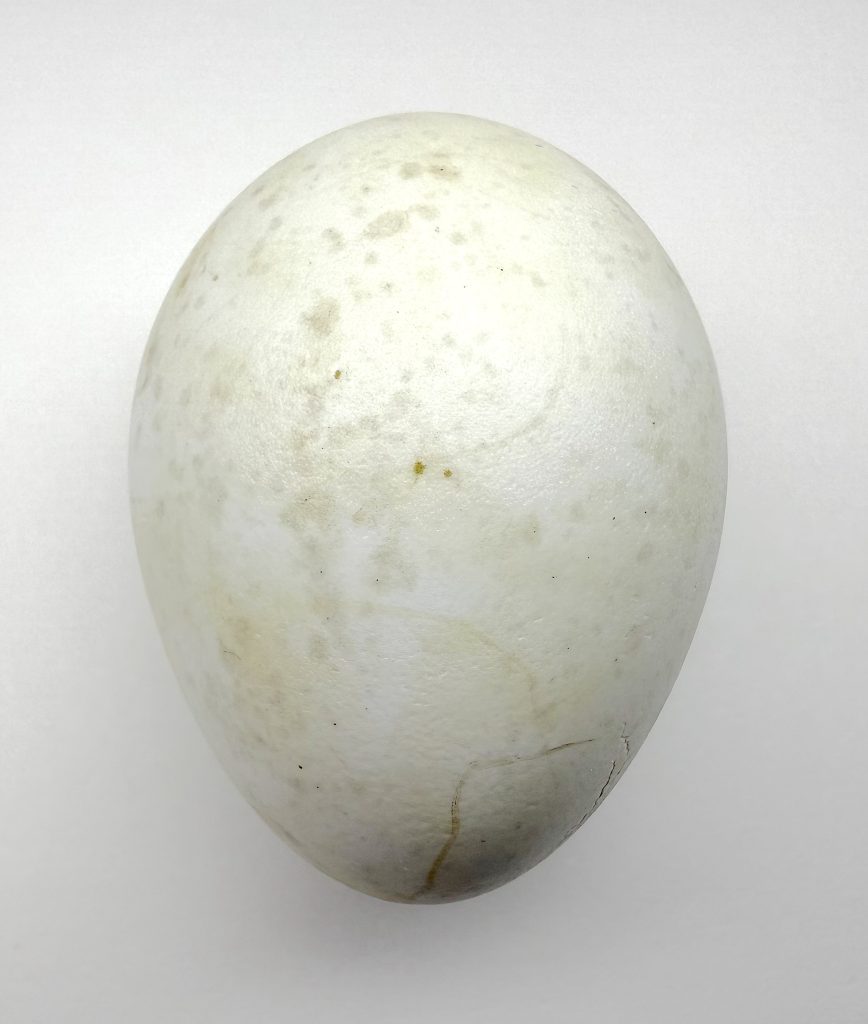
The two pigments are often deposited somewhat independently. Biliverdin is typically laid down earlier or deeper in the shell matrix, which is why eggs colored by biliverdin, like blue eggs, tend to be colored throughout the shell thickness, the interior of a blue eggshell being bluish. For example, the blue-green eggs of the Guira Cuckoo have pigment that permeates the entire shell, visible even on the inside. Protoporphyrin, in contrast, is usually deposited closer to the surface, often as a coating or as spots after most of the calcite is in place. Thus, brown or speckled eggs often have pigment concentrated on the outer shell and cuticle. If the outer layer is scrubbed or chemically removed, a brown egg can appear white underneath. In chickens, it’s noted that 13–20% of the total pigment may reside in the cuticle, with the rest in the outer shell layers. After pigmentation, a colorless cuticle layer consisting of protein may be added on top in the last hour or so for some species, although in many cases the pigmented cuticle is the final layer.
Because pigment deposition happens late in the process, any disruption to the egg’s schedule can affect coloration. For instance, if a hen is startled and lays an egg prematurely, the egg may be paler or missing its usual speckles due to insufficient pigment application. Conversely, if an egg is retained slightly longer than normal, additional calcium may be laid down over the pigment, resulting in an unusually pale, chalky-looking egg. Hormones also play a role in regulating pigment deposition. Estradiol and progesterone levels influence the shell gland’s pigment secreting cells, ensuring that biliverdin and protoporphyrin deposition occur in a coordinated way without interfering with each other. The result is a consistent species-specific egg coloration pattern under normal conditions.
Biological purpose and evolutionary advantages of egg coloration
Why do birds lay colored eggs at all? Biologists have long explored multiple, non-mutually-exclusive hypotheses to explain the evolution of eggshell coloration. The functions of egg coloration can be broadly grouped into categories such as camouflage, communication/signaling, and structural or protective roles. Below, we detail these functions and their evolutionary significance, with examples:
Camouflage and crypsis
For many birds, especially those that nest in exposed locations, egg coloration provides camouflage to reduce detection by predators. An egg’s background color and any spots or blotches can help it blend into the nesting substrate such as soil, leaves, or rocks. Ground-nesting species in particular benefit from cryptically colored eggs. For example, the eggs of a Killdeer are a buff color with dark speckles that closely resemble pebbles and dirt found in it shoreline habitat, making them hard to spot on open ground. Similarly, nightjars and plovers lay mottled eggs that match the pattern of the forest floor or sand. This background-matching or disruptive pattern can greatly increase egg survival by making the eggs less conspicuous. In fact, the evolution of brown and speckled eggs is thought to coincide with birds moving to open nests millions of years ago. Pigmented, camouflaged eggs would have been strongly favored once eggs were no longer hidden in burrows or covered nests.
Most cavity-nesting birds, like woodpeckers, owls, and many ducks that nest in tree holes, lay plain white eggs, presumably because those eggs are hidden from predators inside dark cavities and do not require camouflage. White eggs in dark cavities may also help the parent birds locate and tend to their eggs in limited light. However, some species have colorful eggs despite open nests e.g. the bright blue eggs of the open-nesting American Robin. In such cases, other factors (like signaling, as discussed below) might be at play, or the nest placement among leaves may obscure the eggs from view enough that outright camouflage is less critical.
Communication, signaling, and recognition
Egg coloration can serve as a means of communication or signaling within or between species. Several hypotheses fall under this category:
- Brood parasitism and host recognition
In host-parasite coevolution, egg color and pattern are critical. Brood parasites like cuckoos lay their eggs in the nests of other species, so they have evolved eggs that mimic the appearance of their host’s eggs to avoid rejection. For example, the Common Cuckoo has distinct genetic lineages (“gentes”) each laying eggs that closely match a particular host species’ eggs in color and pattern. Conversely, host birds have evolved the ability to recognize eggs that deviate from their own and eject them. This arms race has driven a remarkable convergence in egg appearance between parasites and hosts. As a result, many host species’ eggs are heavily pigmented or patterned in species-specific ways so that foreign eggs can be recognized. A bird whose eggs all look alike can more easily spot an odd intruder egg. Indeed, one reason for pigmented eggs is to help parents detect parasitic eggs laid by other birds. For example, if a Brown-headed Cowbird lays its plain-looking egg in a Song Thrush’s nest, the thrush may recognize the intruding egg because it doesn’t match the thrush’s usual blue-spotted egg appearance and thus reject it. In well-lit nests, color is often the primary cue for recognition of foreign eggs, while in dimmer nests, birds may rely on a combination of color and pattern cues. - Individual or colony recognition
In species that nest in large colonies or dense groups, eggshell patterns may help parent birds identify their own eggs among many. A famous example is the Common Guillemot, a seabird that nests on crowded cliff ledges. Guillemots lay a single egg with an extremely variable array of spots, squiggles, and base colors ranging from white to blue-green. Each female’s egg pattern is like a fingerprint. This variation is thought to allow parent guillemots to recognize their own egg in the collective jumble on the colony ledge. Studies of colonially-nesting birds have noted subtle but consistent differences in egg appearance among individuals, supporting the idea that eggshell patterns function in parental recognition. In contrast, birds that nest alone or in isolated pairs have less need for such individual egg signatures. - Sexual signaling and mate communication
Another intriguing hypothesis is that egg color, especially bright blue-green coloration, serves as a signal of female quality to the male partner. This is often referred to as the sexual selection hypothesis for eggshell coloration. The idea is that biliverdin-based blue eggs might indicate a healthy female with good antioxidant capacity. Biliverdin is an antioxidant, and its deposition in the eggshell could be costly to the female because it’s a resource that could otherwise be used to quench free radicals in her body. Therefore, only females in prime condition might afford to lay very vivid blue eggs, making egg color a potential “signal” of her genetic quality or health status. In species where males contribute to parental care, a bright clutch of eggs could stimulate the male to invest more in the offspring, believing they are high-quality. For example, in the American Robin, experiments have shown males feed their chicks more when the eggs were a brighter blue. There is evidence in some species that egg color correlates with female condition or diet (see next section) and that males adjust their behavior based on egg appearance. However, this hypothesis is debated – some studies find no direct link between egg color and female quality once other factors are controlled. It’s possible that egg coloration signals investment in the current offspring rather than the inherent quality of the female. In any case, the signaling hypothesis has spurred much research and likely applies in certain ecological contexts, particularly for blue-green eggs in open-nesting birds. - Embryo signaling
A less-studied idea is that egg color could signal something to the developing embryo. For instance, pigmentation might regulate the amount of light, including ultraviolet, that penetrates the shell and reaches the embryo. Different pigments and colors could modulate embryonic development rates or hormone production by controlling light exposure. It has been suggested that pigments can protect embryos from harmful UV radiation or conversely allow sufficient light for embryonic circadian cues. This idea overlaps with the category below regarding protection, but it highlights that egg color might be an adaptive trait considering not just external viewers, i.e. predators or parents, but the embryo’s needs as well.
Structural and protective functions
Beyond visual functions, eggshell pigments might confer direct physical benefits to the egg:
- Shell strength and integrity
Recent research has found that eggshell pigmentation can compensate for thinner shells and improve their strength. Protoporphyrin, in particular, often appears more where the shell is thinner. For example, many passerine birds have a concentration of speckles in a ring around the blunt end of the egg, known as a “pigment belt” or corona. Studies on Great Tit eggs showed that unpigmented parts of shell were slightly thinner than pigmented parts, and the spots containing protoporphyrin were associated with greater shell fracture resistance. The darker pigment might help strengthen weak areas or indicate areas of extra calcium deposit. One hypothesis is that when a female is constrained in calcium and produces a thinner shell, her body may add more protoporphyrin to the shell as a reinforcement or as a by-product of shell formation stress, effectively plugging microcracks or strengthening the structure. Thus, maculation (spotting) could be partly an adaptation to maintain egg integrity. While pigmentation is only a thin layer and not as strong as the calcite itself, it may still have micro-scale effects on shell toughness or stiffness. More research is ongoing, but a structural reinforcement role for pigments like protoporphyrin has been supported by some mechanical tests. - Thermoregulation
The idea here is that darker eggs might absorb more solar radiation and warm up faster, which could be beneficial in cool climates, whereas lighter eggs reflect more heat, keeping them cooler in hot environments. There is mixed evidence for this “egg thermoregulation” hypothesis. On one hand, darkly speckled eggs left in the sun do heat up more quickly than white eggs. Ground-nesting birds in cold regions, like some plovers in the Arctic, often have dark or heavily speckled eggs, which might help them attain optimal temperature when parents are off the nest. On the other hand, in very hot environments, too much dark pigment could overheat the embryo. Overall, thermoregulation might be a secondary effect of egg color, beneficial in some situations, but usually constrained by the primary need for camouflage. Some researchers have proposed that infrared reflectance properties of biliverdin vs. protoporphyrin could influence how eggs lose or retain heat, but results suggest any thermal advantage is likely small compared to behavioral thermoregulation by the parents i.e., shading or incubating the eggs. - UV protection
As mentioned under signaling, pigments absorb certain wavelengths of light. It’s known that the cuticle and pigments can absorb ultraviolet (UV) light, preventing it from penetrating the shell. Excess UV can potentially harm developing embryos or cause them to develop too quickly. A study found that removing the cuticle increased UV transmission through the shell, implying the outer pigmented layers normally block some UV. Both white and colored eggshells have structural and chemical components that modulate UV transmission. While the calcium carbonate of the shell and the organic matrix contribute to UV blocking, darker pigments could provide additional UV shielding. This “chemoprotection” might be especially relevant for species whose eggs are exposed to direct sunlight. However, it’s an area that requires more research, as the avian visual system can see some UV meaning what looks like a solid color to us might have a UV-reflectance pattern visible to birds for egg recognition or other purposes. In any case, pigmented eggs likely strike a balance between allowing some light for embryonic development cues and blocking harmful levels of radiation.
It is important to note that these functions are not mutually exclusive. For example, the eggs of the Great Reed Warbler are camouflaged (olive with spots) to hide from predators, but they also have unique patterns to help the warblers detect cuckoo parasitism, and the pigment may incidentally add strength to the shell. The multi-faceted roles of egg coloration underscore why it has persisted as a “pliable” trait that can evolve under different selective pressures.
Ancient origins of egg coloration
Recent paleontological research has revealed that some non-avian dinosaurs had colored eggs. Fossilized eggshell analyses show evidence of biliverdin and protoporphyrin in the eggs of certain dinosaurs closely related to birds, meaning the genetic capacity for egg coloration is ancient. This suggests that the varied egg colors we see today in birds might be inherited from dinosaur ancestors rather than all evolving from a white baseline. It challenges the old assumption that ancestral bird eggs were white. Instead, some dinosaurs laid blue-green or brown eggs, possibly for camouflage or thermoregulation in their environment. Evolution has likely tweaked egg colors in each lineage in response to new predators, climates, and nesting styles over time, occasionally even losing pigmentation in lineages that didn’t need it e.g. many cavity nesters.
Conclusion
Egg coloration in birds is a fascinating interplay of biology, chemistry, and evolution. Two main pigments, biliverdin and protoporphyrin, create all the blues, greens, browns, and reds on bird eggshells, deposited in the shell gland during the last stages of egg formation. These pigments and the patterns they produce have evolved to serve multiple purposes: camouflaging eggs from predators, signaling information to mates or parents, thwarting brood parasites, protecting the developing embryo from sunlight and strengthening the shell. The immense variety of egg colors across species, from the immaculate white of an owl’s egg to the speckled olive of a quail’s, or the bold turquoise of a robin’s, reflects different environmental pressures and survival strategies. Variations in egg color can even be found within a species or individual, influenced by diet, health, and subtle genetic differences. What remains consistent is that egg coloration is an adaptive trait honed by natural selection to maximize reproductive success. As scientific techniques advance, for example, detecting pigment traces in fossil eggs or genomics of eggshell pigment pathways, we continue to uncover new insights into how and why birds color their eggs the way they do. In the end, the colorful eggs we see in a bird’s nest represent a complex adaptive story; a blend of chemistry and ecology that ensures the next generation of birds has the best chance of survival.
Sources: The information in this report is supported by scientific studies and reviews on avian eggshell pigmentation, including physiology of pigment deposition, the chemical nature of eggshell pigments, and numerous evolutionary ecology studies on the function of egg coloration.
Here is a list of sources used in the article, along with their website names and URLs:
- “A survey of avian eggshell pigments”
ScienceDirect
https://www.sciencedirect.com/science/article/abs/pii/0305049176901838 - “Mechanisms associated with the depigmentation of brown eggshells”
ScienceDirect
https://www.sciencedirect.com/science/article/pii/S0032579121003072 - “The pigments in eggshell with different colour”
ScienceDirect
https://www.sciencedirect.com/science/article/pii/S1751731123000721 - “The Fascinating Science Behind Egg Colors, Shapes, and Shades”
Poultry Producer
https://www.poultryproducer.com/the-fascinating-science-behind-egg-colors-shapes-and-shades/ - “Dinosaur origin of egg color: oviraptors laid blue-green eggs”
PubMed Central (PMC)
https://pmc.ncbi.nlm.nih.gov/articles/PMC5580385/ - “Avian Coloration Genetics: Recent Advances and Emerging Questions”
Oxford Academic – Journal of Heredity
https://academic.oup.com/jhered/article/112/5/395/6272461 - “To Prevent Oxidative Stress, What about Protoporphyrin IX”
PubMed Central (PMC)
https://pmc.ncbi.nlm.nih.gov/articles/PMC10525153/ - “Duck egg blue and oviraptor green: study reconstructs colour of dinosaur eggs”
The Guardian
https://www.theguardian.com/science/2017/oct/11/duck-egg-blue-and-oviraptor-green-study-reconstructs-colour-of-dinosaur-eggs - “Eggshell biliverdin and protoporphyrin pigments in a songbird”
ResearchGate
https://www.researchgate.net/publication/318971884_Eggshell_biliverdin_and_protoporphyrin_pigments_in_a_songbird_are_they_derived_from_erythrocytes_from_blood_plasma_or_from_the_shell_gland - “Bird eggs: Current Biology”
Cell Press
https://www.cell.com/current-biology/fulltext/S0960-9822%2822%2901201-5 - “Eggshell Pigments–from Formation to Deposition”
SAGE Journals
https://journals.sagepub.com/doi/10.3184/175815511X13228269481875 - “Scientists crack mystery of bird eggs’ colour variation”
The Guardian
https://www.theguardian.com/science/2019/oct/28/scientists-crack-mystery-of-bird-eggs-colour-variation - “Eggshell Biliverdin and Protoporphyrin Pigments in a Songbird”
The University of Chicago Press Journals
https://www.journals.uchicago.edu/doi/abs/10.1086/694297 - “Eggshell color Eggsplained”
Hendrix Genetics Laying Hens
https://layinghens.hendrix-genetics.com/en/articles/eggshell-color-eggsplained/ - “Eggshell pigmentation: a review”
Taiwan Livestock Research Institute
https://www.tlri.gov.tw/redirect_file.php?id=1856&theme=personal_work - “Imperfectly camouflaged avian eggs: artefact or adaptation?”
Princeton University
https://oar.princeton.edu/rt4ds/file/2372/imperfectly.pdf - “Study of the Deposition Process of Eggshell Pigments Using an”
ScienceDirect
https://www.sciencedirect.com/science/article/pii/S0032579119392570 - “Recent advances in avian egg science: A review”
ScienceDirect
https://www.sciencedirect.com/science/article/pii/S0032579119315895 - “A Review of eggshell pigmentation”
Taylor & Francis Online
https://www.tandfonline.com/doi/abs/10.1079/WPS19870016 - “Blue Eggshell: What Pigments Create This?”
American Poultry Association
[https://amerpoultryassn.com/2021/

